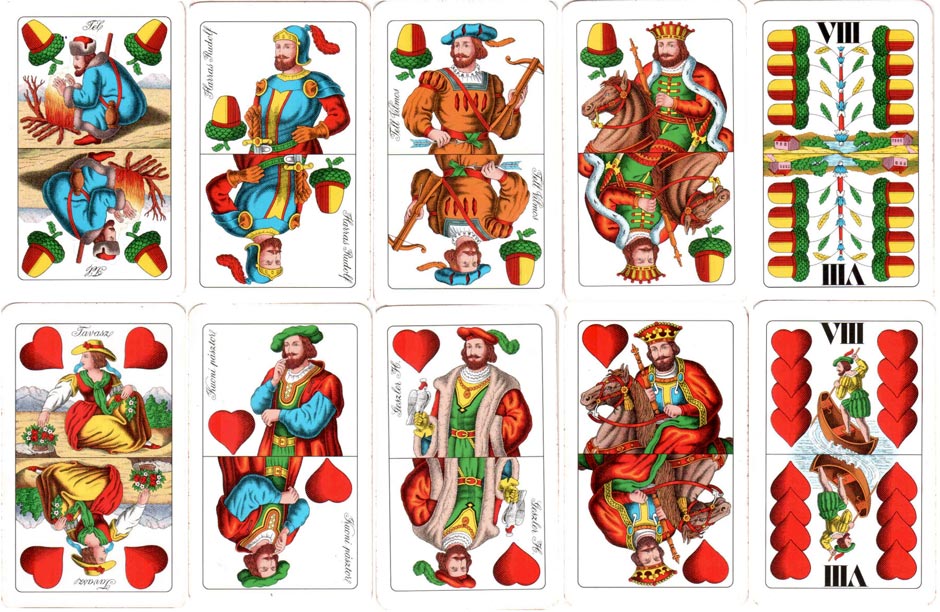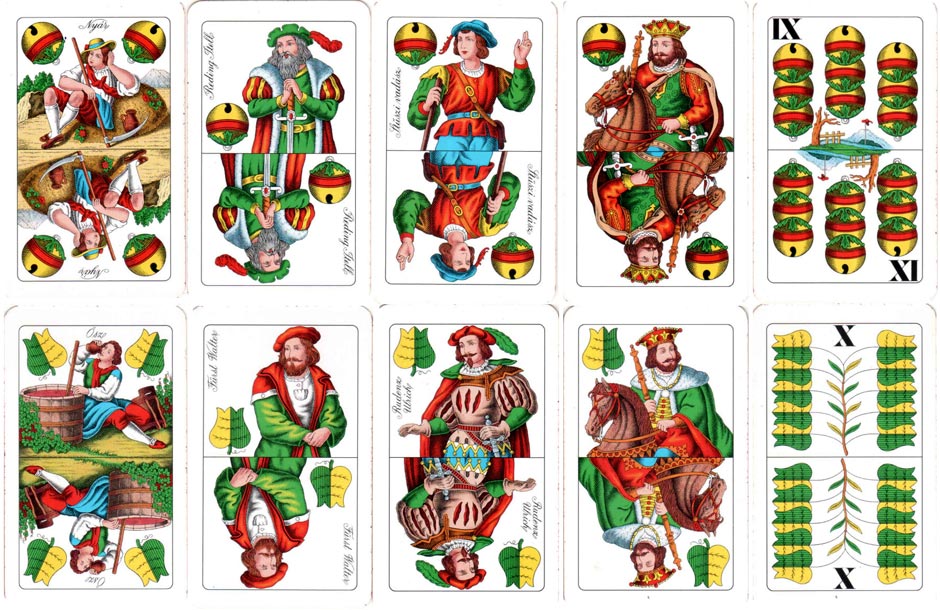Hungarian Seasons pattern
The Hungarian Seasons pattern. With the Hungarian deck you can play a lot of card games. Every village has its own game and rules with this card deck.

Based on the legend of William Tell
Although primarily associated with Hungary, the deck was also used in Austria, Bohemia and Bosnia. Featuring German suit symbols, the 'Hungarian' or 'Seasons' pattern depicts seasonal scenes on the four Aces. For example, the Ace of Acorns shown below (top row) depicts a man warming his hands, representing winter... and so on. The Kings are mounted on horseback and the over- and under-knaves are usually named and portray medieval Central European heroes. Cards are double-ended and packs contain 24, 32 or 36 cards: typically 7-8-9-10, Lower (Knave or Jack), Upper (Knight or Noble), King, Ace.
Above: two early editions of Hungarian 'Seasons' pattern, both are stencil-coloured. Piatnik Nándor és Fiai (Ferdinand Piatnik and Sons) operated in Budapest between 1896-1950. Unio Playing Card Factory (Budapest) was active between 1903-1909 until the firm was take over by Piatnik in 1909. The 30f tax stamp narrows the date to between 1906-1909. Images courtesy Renee Martin.
“...this is the most popular card type in Hungary. Maybe it's more popular than French style poker cards. With the Hungarian deck you can play a lot of card games. Every village has its own game and rules with this card deck. I know about 50 games with it. And everybody can play with these cards minimum 1 game. So this is the why I say this is the most popular card type in Hungary.” [Attila Bagossy]


Above: Hungarian 'Seasons' pattern, 32 cards. The cards with two pips are always called Aces, not 'Twos' or 'Deuces'. The hierarchy of the cards should run 7-8-9-10, Lower (Knave or Jack), Upper (Knight or Noble), King, Ace. The images representing the four seasons on the Aces also highlight them as the most special in the series. The suits are correctly identified as Nut (acorn), Pumpkin, Red (Hearts or Coeur, French for heart), and Green (or Grape, szölö in Hungarian). In too many references elsewhere, Pumpkins are incorrectly called Bells. The names shown on the face cards also correspond, as part of the William Tell legend, to the names of characters in Schiller's famous "Wilhelm Tell" epic. The main heroes and villains are all represented, with their names Hungarianized, so that William Tell is shown as Tell Vilmos, for example. Schiller's classic style of writing reminds of Shakespeare's plays. Thanks to Kate Jones for these extra notes.
Attila Bagossy writes: "I used some name conventions in the name of the files:
abbreviation | Hungarian name | English name (in my opininon)"
- Colors -
m - Makk - Nut
t - Tök - Pumpkin
p -Piros - Red
z - Zöld - Green
- Card Types -
also - Alsó - Lower
asz - Ász - Ace
felso - Fels? - Upper
het - Hét - Seven
kilenc - Kilenc - Nine
kiraly - Király - King
nyolc - Nyolc - Eight
tiz - Tíz - Ten
FURTHER REFERENCES
Playing-Card Tax Stamps from Hungary: www.endebrock.de►

By Simon Wintle
Member since February 01, 1996
Founder and editor of the World of Playing Cards since 1996. He is a former committee member of the IPCS and was graphics editor of The Playing-Card journal for many years. He has lived at various times in Chile, England and Wales and is currently living in Extremadura, Spain. Simon's first limited edition pack of playing cards was a replica of a seventeenth century traditional English pack, which he produced from woodblocks and stencils.
Related Articles

Austria Ski Team playing cards
Photos of members of the Austrian skiing team replace the normal courts on two different packs.

Le Roi bridge
Reprint of a Piatnik (Budapest) pack of 1927 with Hungarian historical figures and scenic aces.

Postabank 3
Caricatures of German personalities on a promotional pack for a Hungarian commercial bank.

Postabank 1
Caricatures of Hungarian politicians on a promotional pack for a commercial bank.

Pirates of the Caribbean: At World’s End
Pack featuring six images from the Disney film of the same name, on cards made for Eastern Europe.

Winnie the Pooh Rummy
Disney’s Winnie the Pooh and friends on a pack made for Eastern Europe.

The Chronicles of Narnia: Prince Caspian
Characters and scenes from the Disney film of the same name, on a pack made for Eastern Europe.

Disney Princess
Featuring Disney Princesses and Enchanting Tales in two sizes of pack made for Eastern Europe.

Mickey Mouse Rummy
Mickey Mouse, Donald Duck and other Disney characters on a pack made for Eastern Europe.

Krónikás kártya
A German-suited pack from Hungary in honour of the millennium.

Budapest souvenir
Colour views of the Hungarian capital, Budapest, on all the courts and Aces.

Joshi Bharát Tarot
A set of the major arcana created by an Indian fortune-teller living in Hungary.

Charta Bellica
“Charta Bellica” playing cards produced by Piatnik, Budapest in 2009.

IBUSZ folklore playing cards
Hungarian folklore pack produced by IBUSZ travel agency, c. 1965.

Fake ‘Four Seasons’ pattern
More than just a copy, this is a fake!

Römihártya
Römihártya pin-up deck from Hungary.
Most Popular
Our top articles from the past 28 days




